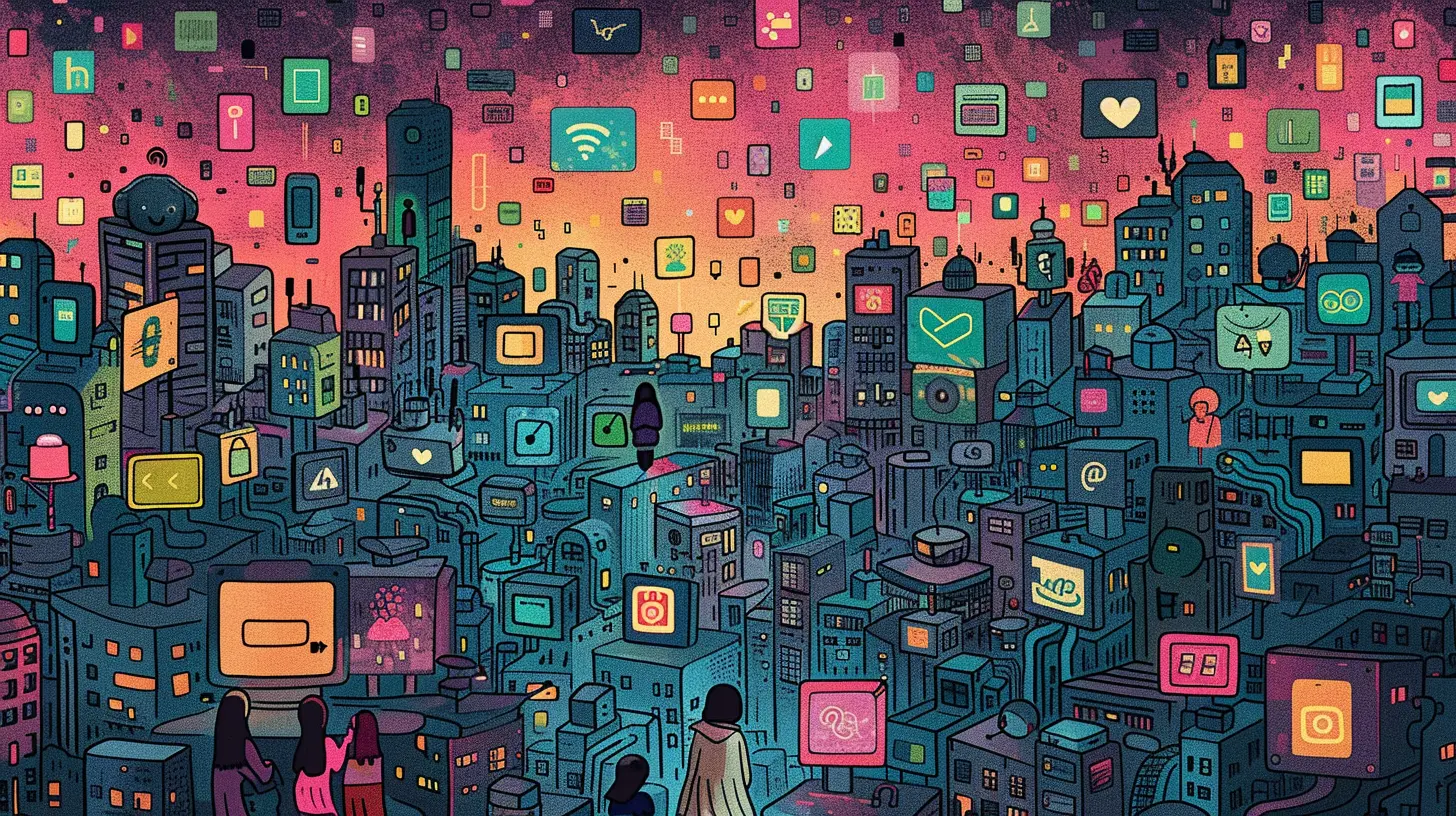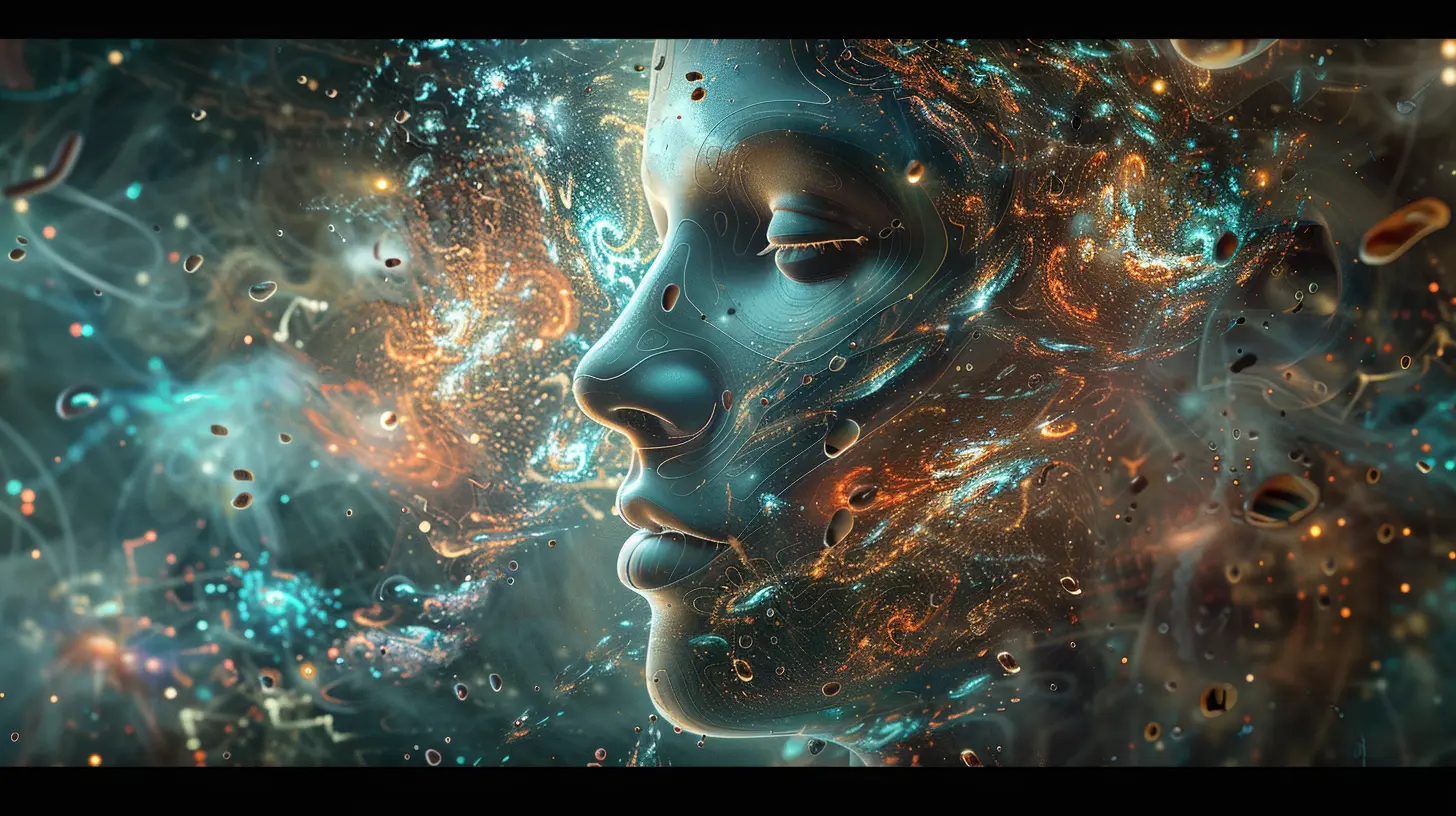Machine Learning in Social Media: How Algorithms Shape Our Experience
2 February 2025
Introduction:
Ever wondered why your social media feed seems to know exactly what you like? Whether it's a video of a cute dog rolling down a hill or a meme that hits right in the feels, it’s no coincidence. Behind the scenes, machine learning algorithms are working tirelessly, fine-tuning your experience, and making sure you see what you’re most likely to engage with. But how exactly do these algorithms shape our social media experience? And more importantly, what does that mean for us as users?
Let’s dive into the world of machine learning in social media and explore how algorithms impact what we see, how we interact, and even how we feel about our online presence.

What is Machine Learning?
Before jumping into the nitty-gritty of social media algorithms, let’s start with the basics. What exactly is machine learning?In simple terms, machine learning (ML) is a subset of artificial intelligence (AI) where machines (or computers) learn from data, identify patterns, and make decisions without being explicitly programmed for every task. Think of it like teaching a dog tricks. After a lot of practice, the dog learns what to do without you needing to guide it every step of the way. In the same way, machine learning algorithms get better at predicting what you’ll like the more you use social media.
Sounds cool, right? But here’s the kicker — it’s not just about showing you cat videos. Machine learning is also shaping your opinions, influencing your shopping habits, and even determining which friends' posts you see more often. Let’s take a closer look at how this all works.

How Do Social Media Algorithms Use Machine Learning?
Social media platforms like Facebook, Instagram, Twitter, TikTok, and LinkedIn use machine learning to curate the content you see. But how does it actually happen? There are a few key components to how these algorithms function:1. Personalized Feed
Ever noticed that after watching one type of video on Instagram, your feed seems to be flooded with similar content? That’s machine learning at work. Social media platforms analyze your behavior—how long you watch a video, what you like, what you comment on, and even what you share. Based on this data, the algorithm learns what you're interested in and adjusts your feed accordingly.Think of it like having a personal curator for your content. The more you interact, the better the algorithm gets at showing you things you’re likely to engage with. The goal? To keep you on the platform for as long as possible.
2. Content Recommendation Systems
Recommendation systems are the backbone of platforms like YouTube and TikTok. Using machine learning, these platforms recommend videos, posts, and articles based on your past behavior. For instance, if you’ve been binge-watching tech reviews, the next time you log in, your homepage will be filled with similar content.These recommendation systems use collaborative filtering, a type of machine learning technique, to compare your activity with other users who have similar tastes. Think of it like hanging out with a group of friends who always seem to know what movies or shows you’d love.
3. Targeted Ads
Ah, the ads. Ever searched for something online and then seen ads for it on your Facebook or Instagram feed? That’s no accident. Social media platforms use machine learning to serve highly targeted ads based on your browsing history, likes, and even comments.The platforms gather data from your online behavior and create a profile that advertisers can target. And because machine learning algorithms are constantly analyzing, the ads become more refined over time, increasing the chances you'll click on them. While some might find this helpful, others feel it crosses into creepy territory.
4. Engagement Prediction
Ever wondered how social media platforms seem to know which posts will go viral? Machine learning algorithms can predict the likelihood of a post gaining traction based on engagement metrics like likes, shares, and comments. This not only helps platforms highlight trending content but also influences what gets pushed to the top of your feed.For example, if a post is getting a lot of engagement shortly after being published, the algorithm might assume it's high-quality content and show it to more people, further increasing its reach.
5. Sentiment Analysis
Ever noticed how platforms like Twitter or Facebook show you "trending" topics? These platforms use machine learning, specifically a technique called sentiment analysis, to gauge the emotions behind posts. By analyzing the words and phrases people use, algorithms can determine whether a post is positive, negative, or neutral.This is often used to highlight trending news or public sentiment on specific topics. The same analysis can also be used by advertisers to figure out how people are reacting to their products or campaigns.

The Impact of Machine Learning on User Experience
Okay, so now we know how machine learning algorithms work. But what does this mean for you as a user?1. Echo Chambers & Filter Bubbles
One of the most talked-about impacts of machine learning algorithms in social media is the creation of "echo chambers" or "filter bubbles." Since the algorithms prioritize showing you content similar to what you’ve engaged with before, you end up seeing the same types of opinions, ideas, and content over and over again.While this might make your feed more enjoyable (after all, who doesn’t like seeing things they agree with?), it can also limit your exposure to diverse viewpoints. Over time, you might end up in an echo chamber where you only hear opinions that reinforce your own beliefs, making it harder to see things from a different perspective.
2. Addiction to Social Media
The constant stream of personalized content can keep you coming back for more. And that’s no accident. Machine learning algorithms are designed to maximize engagement, which often translates to maximizing the amount of time you spend on the platform.This has led to concerns about social media addiction, where users find it difficult to disconnect from their feeds because they’re constantly being served content that’s tailored specifically to their interests.
3. Privacy Concerns
We can’t talk about machine learning in social media without touching on privacy. To function effectively, algorithms need a lot of data. That means social media platforms are collecting and analyzing your behavior, often in ways that aren’t always transparent.While some users don’t mind this trade-off for a more personalized experience, others are concerned about how much data is being collected and how it’s being used. With growing awareness around privacy issues, platforms are facing increased scrutiny about how they manage user data.
4. Mental Health Implications
There’s no denying that social media plays a role in shaping our mental health. Machine learning algorithms can exacerbate this by constantly showing us content that triggers emotional responses, whether it’s the perfect vacation photo from a friend or a controversial news article that gets your blood boiling.These emotionally charged posts tend to get higher engagement, which means the algorithm is more likely to show them to you. Over time, this can lead to increased stress, anxiety, or feelings of inadequacy.

The Future of Machine Learning in Social Media
As machine learning continues to evolve, so too will its role in social media. Here are a few trends we can expect to see in the coming years:1. More Personalized Experiences
As algorithms become more advanced, the level of personalization will only increase. This could mean even more tailored content, ads, and recommendations. While this might improve user experience, it also raises questions about how much control we’re giving up when it comes to our online experiences.2. Better Moderation
One of the biggest challenges for social media platforms is moderating content. Machine learning can help with this by identifying harmful or inappropriate content more quickly. For example, algorithms can be trained to detect hate speech, fake news, and misinformation, helping platforms take action before the content spreads widely.3. Increased Transparency
In response to growing concerns about privacy and data usage, social media platforms may become more transparent about how their algorithms work. This could include giving users more control over what data is collected and how it’s used, as well as providing clearer explanations of why certain content is being recommended.4. AI-generated Content
We’re already seeing the rise of AI-generated content, and this trend is likely to continue. From deepfake videos to AI-written articles, the line between human and machine-generated content is becoming increasingly blurred. This raises ethical questions about authenticity and trust, especially in a world where misinformation is already a major issue.Conclusion
Machine learning has completely transformed the way we interact with social media. From personalized feeds and content recommendations to targeted ads and predictive engagement, these algorithms shape nearly every aspect of our online experience. While there are clear benefits—like more relevant content and better user experiences—there are also challenges, including privacy concerns, the creation of echo chambers, and potential impacts on mental health.As we continue to navigate this digital landscape, it’s important to stay informed about how these algorithms work and think critically about the implications they have on our lives. In the end, while machine learning might be behind the scenes, we, as users, still have the power to shape the conversation.
all images in this post were generated using AI tools
Category:
Machine LearningAuthor:

Adeline Taylor
Discussion
rate this article
17 comments
Genevieve Hayes
This article effectively highlights the dual role of algorithms in social media—enhancing user engagement while raising concerns about echo chambers and misinformation, underscoring the need for transparency and ethical governance.
March 10, 2025 at 8:41 PM

Adeline Taylor
Thank you for your insightful comment! I appreciate your recognition of the complexities of algorithms in social media and the importance of transparency and ethics in their governance.
Ingrid Barron
Algorithms: our digital matchmakers!
February 21, 2025 at 8:12 PM

Adeline Taylor
Absolutely! Algorithms indeed play a crucial role in connecting us with content and people that align with our interests, acting as digital matchmakers in our social media experience.
Fern Lane
This article raises fascinating questions about how algorithms shape our perceptions on social media. How much do these machine learning models influence our choices, beliefs, and connections? I'm eager to explore the implications further!
February 21, 2025 at 5:35 AM

Adeline Taylor
Thank you for your insightful comment! Algorithms indeed play a crucial role in shaping our perceptions and experiences on social media, influencing everything from our beliefs to our connections. I'm glad you're eager to explore these implications further!
Ariadne Chavez
This article effectively highlights the significant role algorithms play in shaping social media experiences. Understanding their influence is crucial for users seeking to navigate information, privacy, and engagement in today's digital landscape.
February 19, 2025 at 5:56 AM

Adeline Taylor
Thank you! I'm glad you found the article insightful. Understanding algorithms is indeed essential for navigating the complexities of social media today.
Easton Kelly
Exciting insights! Machine learning truly transforms our social media experience! 🎉
February 18, 2025 at 7:48 PM

Adeline Taylor
Thank you! I'm glad you found the insights exciting! Machine learning indeed plays a crucial role in enhancing our social media interactions. 🎉
Lyra Daniels
This article effectively highlights the significant impact of machine learning algorithms on our social media experiences. It raises important questions about echo chambers and personalized content. While the technology enhances user engagement, it also risks narrowing perspectives. A balanced approach to algorithm design is essential for healthier online interactions.
February 18, 2025 at 3:59 AM

Adeline Taylor
Thank you for your insightful comment! I completely agree that while machine learning enhances engagement, it’s crucial to consider its effects on diverse perspectives and maintain a balanced approach in algorithm design.
Megan McNaughton
Great insights into the role of machine learning in shaping our social media experiences! It's fascinating to see how algorithms influence content visibility and user interactions. Understanding these dynamics is essential for fostering a more informed and responsible digital environment. Thank you for sharing this thought-provoking article!
February 17, 2025 at 4:05 AM

Adeline Taylor
Thank you for your thoughtful comment! I'm glad you found the insights valuable. Understanding these dynamics is indeed crucial for navigating our digital world responsibly.
Kai McWhorter
This article effectively highlights the dual-edged nature of machine learning in social media. While algorithms enhance personalization, they also risk creating echo chambers and reinforcing biases. A critical examination of their societal impact is essential for fostering a healthier digital environment.
February 16, 2025 at 4:49 AM

Adeline Taylor
Thank you for your insightful comment! I completely agree that a critical examination of machine learning's impact is crucial for navigating the complexities of social media.
Oscar Robinson
Fascinating insights on the power of algorithms in shaping our social media experiences! I'm curious about how these machine learning models balance personalization with privacy. Could this lead to a more authentic connection, or will it further entrench echo chambers? Would love to hear more!
February 15, 2025 at 9:28 PM

Adeline Taylor
Thank you for your comment! Balancing personalization with privacy is indeed a challenge. While machine learning can enhance connections by delivering relevant content, it also risks deepening echo chambers if not managed thoughtfully. Ongoing dialogue and ethical practices are essential for fostering authentic interactions without compromising privacy.
Gunner Butler
Great article! It’s fascinating how algorithms can enhance our social media experiences. Embracing machine learning opens up endless possibilities for connection and creativity. The future looks bright! 🌟
February 12, 2025 at 5:05 AM

Adeline Taylor
Thank you for your kind words! I'm glad you found the article insightful. Indeed, the potential of machine learning in enhancing our social media experiences is truly exciting! 🌟
Laura McEachern
Algorithms: the digital puppeteers of our feeds!
February 11, 2025 at 8:25 PM

Adeline Taylor
Absolutely! Algorithms indeed play a crucial role in curating our online experiences, guiding us through vast amounts of information and shaping our interactions.
Natalia Vasquez
As algorithms curate our feeds, they subtly influence perceptions and behavior, raising essential questions about autonomy, bias, and digital identity.
February 9, 2025 at 9:32 PM

Adeline Taylor
Absolutely! The impact of algorithms on our feeds is profound, affecting not only our perceptions but also our sense of autonomy and identity. It's crucial to critically examine these influences to foster a more informed digital experience.
Jillian Smith
This article beautifully highlights the profound impact of machine learning on our social media experiences. It’s essential we acknowledge both the benefits and challenges of these algorithms. Understanding their influence can empower us to navigate our digital lives more mindfully. Thank you for sharing!
February 9, 2025 at 5:27 AM

Adeline Taylor
Thank you for your thoughtful insights! I'm glad you found the article meaningful. Recognizing both the benefits and challenges of machine learning is crucial for navigating our digital landscape.
Callista Blevins
Great insights! Excited to see how machine learning continues to evolve our experiences!
February 8, 2025 at 8:15 PM

Adeline Taylor
Thank you! Exciting times ahead as machine learning transforms our interactions!
Lexi Moore
Algorithms: because who needs real friends when you can have a perfectly curated feed?
February 4, 2025 at 12:48 PM

Adeline Taylor
While algorithms can enhance our online experiences, they should complement, not replace, genuine connections. Balancing digital interactions with real-life relationships is essential for our well-being.
Zevin McKeever
Algorithms dictate our social media experiences, often prioritizing engagement over authenticity. It's time we demand transparency and control over the data that shapes us.
February 3, 2025 at 4:19 AM

Adeline Taylor
Absolutely, transparency and user control are crucial for fostering genuine interactions online. We must advocate for algorithms that prioritize authenticity to enhance our social media experiences.
Thane Foster
This article beautifully highlights the profound impact of algorithms on our social media experiences. It's a reminder of how technology shapes our interactions and the importance of understanding these systems better. Thank you!
February 2, 2025 at 7:28 PM

Adeline Taylor
Thank you for your thoughtful comment! I'm glad you found the article insightful. Understanding these algorithms is crucial for navigating our digital interactions.
MORE POSTS

How to Choose the Perfect Gaming Laptop for Your Needs

The Role of Qubits in Quantum Computing Explained

How Machine Learning is Transforming the World of Finance

Understanding the Differences Between Budget and Premium Wireless Earbuds

The Impact of Drone Technology on Global Shipping

Wireless vs. Wired Mice: Which is Better for You?

The Impact of Smart Home Devices on E-Commerce

Ergonomic Mice for Gamers: Comfort Meets Precision

Understanding Quantum Gates: The Building Blocks of Quantum Circuits

How to Master Drone Flying for Professional Aerial Videography

The Power of TypeScript: JavaScript with Strong Typing